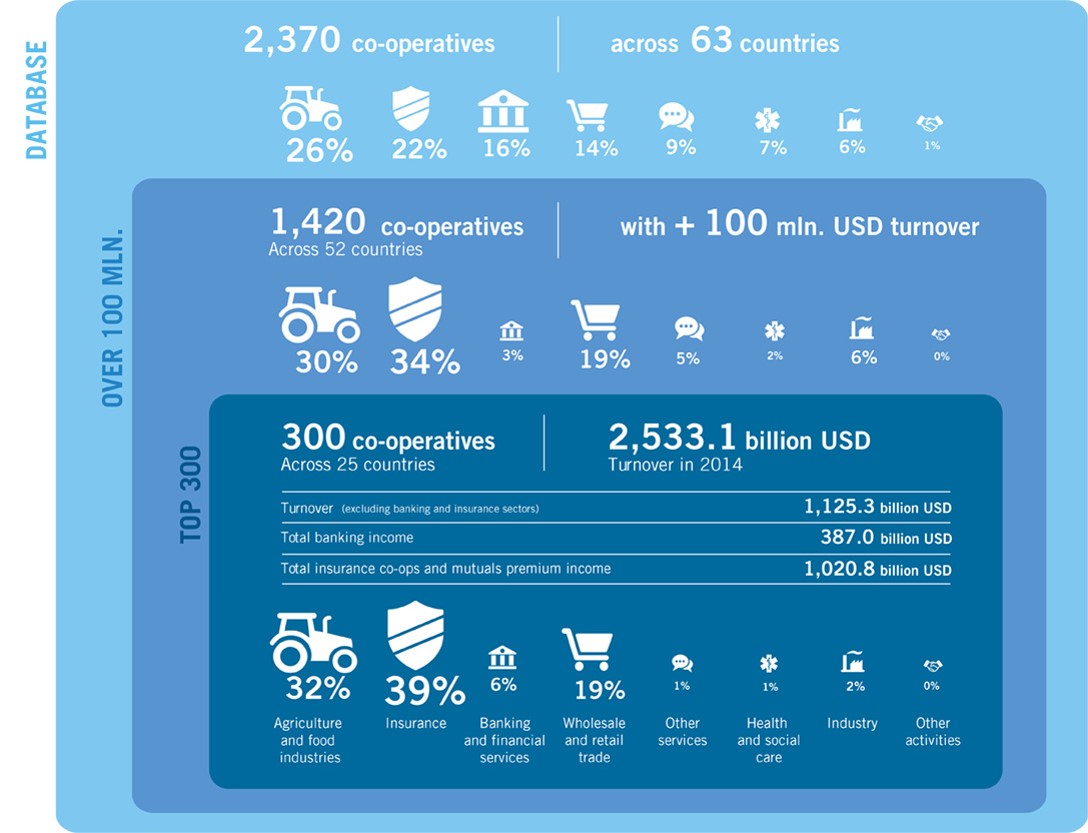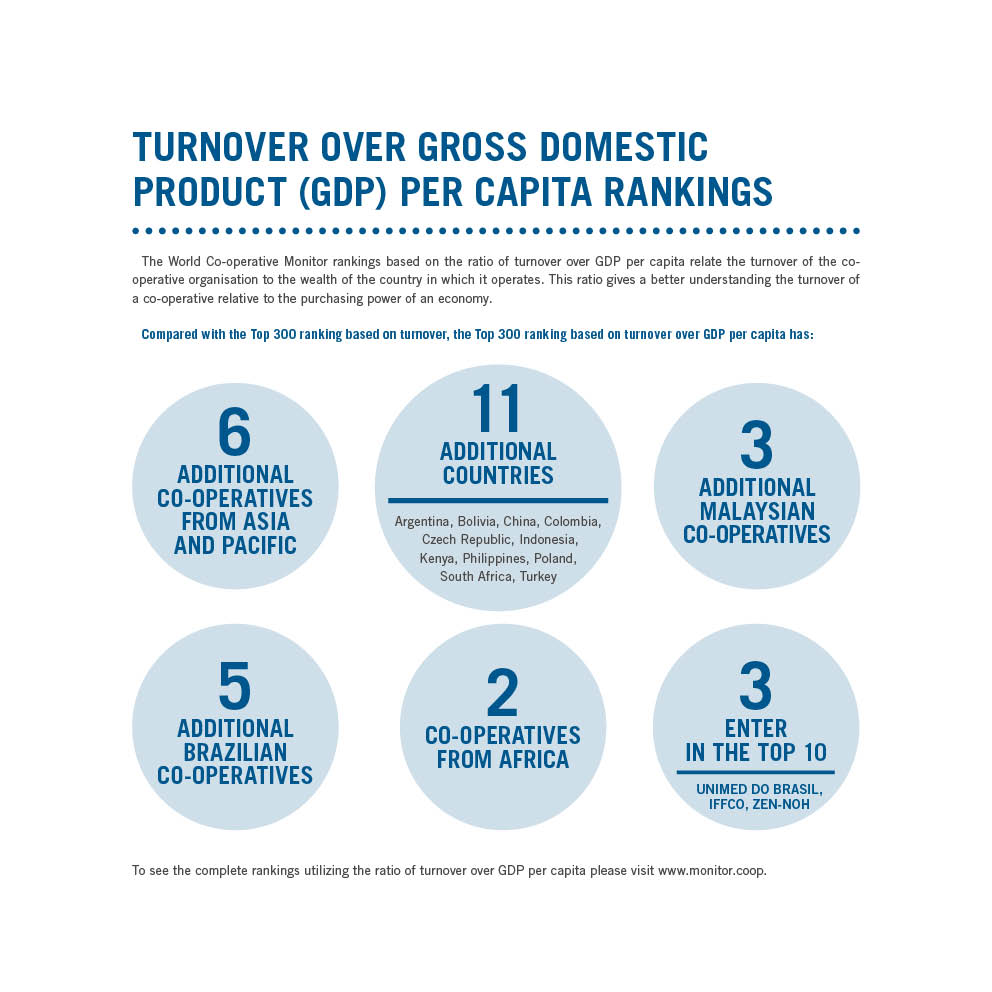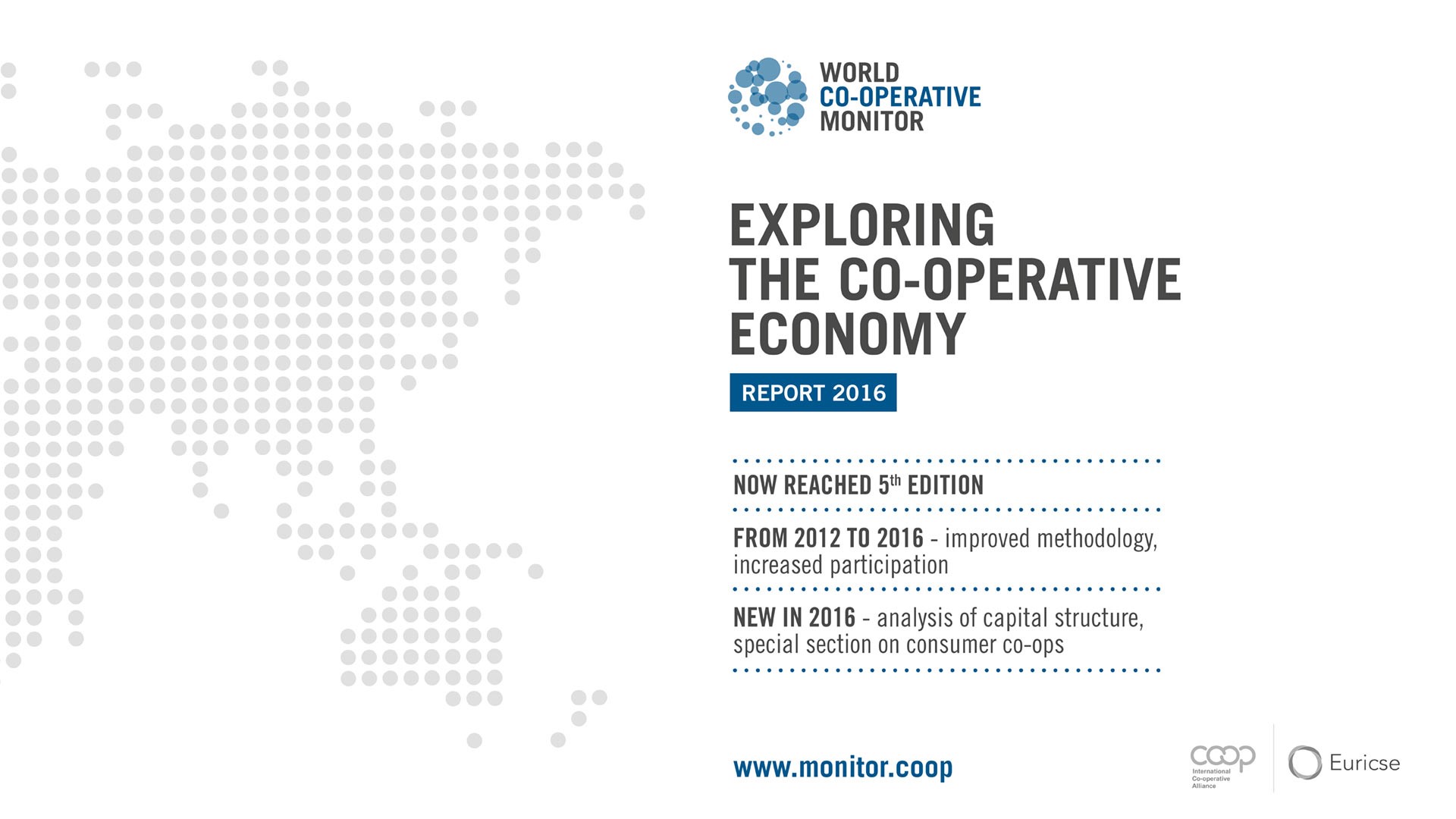Key findings from the World Co-operative Monitor 2016
The World Co-operative Monitor 2016 is the fifth edition of the annual research report produced by the International Co-operative Alliance (the Alliance) with the scientific and technical support of Euricse. The research, widely considered the primary source for global statistics on the economic dimensions of the co-operative movement, includes a new feature in 2016: an analysis of the capital structure of the Top 300 co-operative enterprises. Also included in this year’s edition is a special section focusing on consumer co-operatives within the Wholesale and retail trade sector.
2016 database – findings based on 2014 data, over 100 million, top 300

The top 5 co-operative businesses based on turnover and turnover over GDP per capita


The World Co-operative Monitor collects and analyses data on the world’s largest co-operative and mutual organisations[1]. The top 300 of these co-operatives are ranked based on turnover as well as the ratio of turnover to gross domestic product (GDP) per capita, relating the turnover of the co-operative to the purchasing power of the country in which it operates in a comparable way. Additional analysis in the report includes sectorial rankings based on turnover.
The database contains data collected through an online questionnaire addressed directly to co-operative and mutual organizations. That data is also integrated with existing databases and other data collected by national associations, research institutes, sectorial organizations and others.
The capital structure of co-operative firms
Included in the 2016 report is a new chapter dedicated to exploring co-operative capital. The work expands on previous research commissioned by the Alliance and focuses on the organisations (co-operatives, mutuals, and businesses controlled by co-operatives) present in the Top 300 ranking of this edition of the Monitor. The analysis includes an overview of the Top 300 by region and sector as well as a comparison between co-operative and non-co-operative firms within the Agriculture and food industries sector, in part testing the argument that co-operatives have more difficulties raising capital than other types of firms.
The results show a sector with good capitalization, in financial equilibrium and with sufficient profitability to support growth. While the research is limited to the largest co-operatives only and is small in number, it demonstrates that these organisations do not seem to have particular problems raising capital, or at least no more than other forms of enterprise. Moreover, it seems that there are evident differences between various sectors, but not across different macro-regions, i.e. Asia and the Pacific, Americas, and European regions. The results suggest the need for policies that push towards a governance able to support an increasing level of investment in innovation, while respecting the co-operative nature.
Special focus on Consumer Co-operatives
In addition, in collaboration with Consumer Co-operatives Worldwide (CCW), a sectoral organisation of the Alliance, this year the World Co-operative Monitor also includes a special look at consumer co-operatives within the Wholesale and Retail Trade sector. The aim is to provide readers some insight beyond the numbers into the important contributions these types of co-operatives can make both socially and economically.
Stemming from their values, consumer co-operatives have a strong focus on Social Responsibility. Hence, while emphasis is placed on satisfying the needs and expectations of the members, consumer co-operatives favour a sustainable approach towards the activities of production and distribution, taking into account the sustainable development of local communities, environmental concerns and the health and safety of consumers. As is the case with co-operatives in general, the aim of a consumer co-operative is not to maximize profits, but to be of use to its members and defend their interests.
In this special section of the Monitor, four stories of consumer co-operatives are presented: Alleanza 3.0 (Italy), iCoop Korea (Republic of Korea), NCG/CoMetrics (USA), JCCU (Japan). These four stories were chosen to highlight some interesting initiatives being undertaken by consumer co-operatives around the world, both big and small. Following the stories is an interview with Petar Stefanov, current President of CCW and Central Cooperative Union, Bulgaria.
Petar Stefanov, President of Consumer Co-operatives Worldwide:
“Challenges are even greater, especially nowadays, often due to the unpredictable dynamic of emerging technologies, global crises, open countries, overtrading and overconsumption. In this context, co-operative leaders have an important role in preserving the essence of co-operative business, which has shown adaptability and flexibility to solve social issues, and which gives ideas and approaches to address the challenges of ‘Creating a better world NOW!’”
The 2016 World Co-operative Monitor report was produced by a team of researchers at Euricse with the contribution of Professor Flavio Bazzana, University of Trento, and the scientific support of a committee of international experts and scientists. The project is made possible with the support of our organizational partners: Fundación Espriu and OCB System.
Co-operatives can actively participate in the project by completing the questionnaire at www.monitor.coop.
The complete World Co-operative Monitor report and methodology are available at: www.monitor.coop
[1] Organizations studied include primary co-operatives, co-operative groups and networks, mutual organizations, and non-co-operative enterprises controlled by co-operatives. For a complete discussion of the methodology see www.monitor.coop
